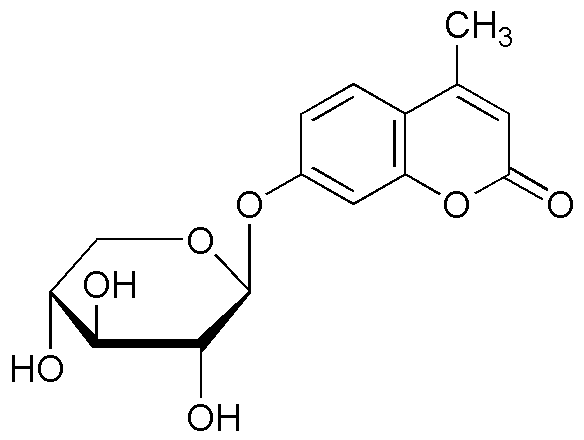4-Methylumbelliferyl-b-D-xylopyranoside is widely utilized in research focused on:
- Enzyme Activity Assays: This compound serves as a substrate for various glycosidases, allowing researchers to measure enzyme activity in biochemical assays effectively.
- Fluorescent Labeling: Its fluorescent properties make it an excellent choice for labeling and tracking glycosylation processes in cell biology studies.
- Plant Research: Used in studies of plant polysaccharides, it helps scientists understand carbohydrate metabolism and the role of xylans in plant structure.
- Food Industry Applications: It can be applied in food science to analyze the presence of specific glycosidases in food products, ensuring quality and safety.
- Clinical Diagnostics: The compound is valuable in developing diagnostic tests for diseases related to carbohydrate metabolism, providing insights into patient health.
General Information
Properties
Safety and Regulations
Applications
4-Methylumbelliferyl-b-D-xylopyranoside is widely utilized in research focused on:
- Enzyme Activity Assays: This compound serves as a substrate for various glycosidases, allowing researchers to measure enzyme activity in biochemical assays effectively.
- Fluorescent Labeling: Its fluorescent properties make it an excellent choice for labeling and tracking glycosylation processes in cell biology studies.
- Plant Research: Used in studies of plant polysaccharides, it helps scientists understand carbohydrate metabolism and the role of xylans in plant structure.
- Food Industry Applications: It can be applied in food science to analyze the presence of specific glycosidases in food products, ensuring quality and safety.
- Clinical Diagnostics: The compound is valuable in developing diagnostic tests for diseases related to carbohydrate metabolism, providing insights into patient health.
Documents
Safety Data Sheets (SDS)
The SDS provides comprehensive safety information on handling, storage, and disposal of the product.
Product Specification (PS)
The PS provides a comprehensive breakdown of the product’s properties, including chemical composition, physical state, purity, and storage requirements. It also details acceptable quality ranges and the product's intended applications.
Certificates of Analysis (COA)
Search for Certificates of Analysis (COA) by entering the products Lot Number. Lot and Batch Numbers can be found on a product’s label following the words ‘Lot’ or ‘Batch’.
Número de catálogo
Número de lote/lote
Certificates Of Origin (COO)
This COO confirms the country where the product was manufactured, and also details the materials and components used in it and whether it is derived from natural, synthetic, or other specific sources. This certificate may be required for customs, trade, and regulatory compliance.
Número de catálogo
Número de lote/lote
Safety Data Sheets (SDS)
The SDS provides comprehensive safety information on handling, storage, and disposal of the product.
DownloadProduct Specification (PS)
The PS provides a comprehensive breakdown of the product’s properties, including chemical composition, physical state, purity, and storage requirements. It also details acceptable quality ranges and the product's intended applications.
DownloadCertificates of Analysis (COA)
Search for Certificates of Analysis (COA) by entering the products Lot Number. Lot and Batch Numbers can be found on a product’s label following the words ‘Lot’ or ‘Batch’.
Número de catálogo
Número de lote/lote
Certificates Of Origin (COO)
This COO confirms the country where the product was manufactured, and also details the materials and components used in it and whether it is derived from natural, synthetic, or other specific sources. This certificate may be required for customs, trade, and regulatory compliance.


